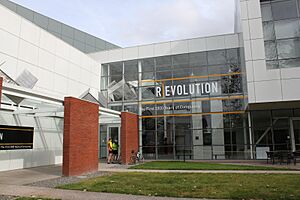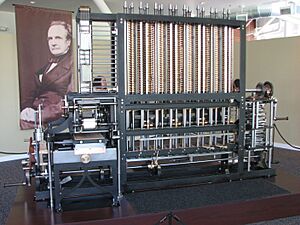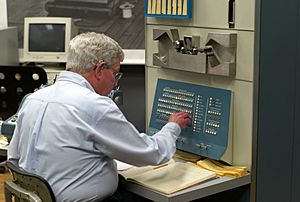Computer History Museum facts for kids
 |
|

The Computer History Museum's front entrance
|
|
| Established | 1996 |
|---|---|
| Location | Mountain View, California, US |
| Type | History and Technology Museum |
| Collection size | Over 1 million objects |
The Computer History Museum (CHM) is an exciting computer museum located in Mountain View, California. It tells the amazing story of computers and how they have changed our lives. You can explore the history of Silicon Valley and see how the computer revolution has impacted society.
Contents
The Museum's Journey: How It Started
The idea for the museum began way back in 1968. A person named Gordon Bell wanted to collect old computer items. At the same time, others were trying to save the Whirlwind computer.
Early Days: From Closet to Museum
- The first small exhibit opened in 1975. It was in a converted coat closet at a company called DEC.
- In 1978, the museum, then called The Digital Computer Museum, moved to a bigger space. It opened to the public in September 1979.
- Famous computer scientist Maurice Wilkes gave the first lecture there in 1979. These lectures are still happening today!
Moving to Boston and Becoming CHM
- In 1982, the museum officially became The Computer Museum (TCM).
- TCM moved to Boston in 1984, finding a new home on Museum Wharf.
- In 1996, a new part, the TCM History Center (TCMHC), was created. NASA gave them an old building at Moffett Field. Many old computer items were sent there from Boston.
- In 1999, TCMHC became its own organization. The original Boston museum closed, and its remaining items were sent to TCMHC in 2000.
- The name TCM was kept by the Boston Museum of Science. So, in 2000, TCMHC changed its name to the Computer History Museum (CHM).
A New Home in Mountain View
- In 2002, CHM opened its current building in Mountain View, California. This building used to belong to Silicon Graphics.
- The museum got a big makeover and reopened in January 2011.
- In 2009, CHM hosted the National Inventors Hall of Fame ceremony. This was special because all the new members that year helped create computer chips.
Fun Programs and Events
The Computer History Museum often hosts public programs called "CHM Live." They invite famous leaders from the tech world to speak. People like Bill Gates, Mark Zuckerberg, and Elon Musk have shared their stories. The museum also celebrates important anniversaries, like 40 years of the Apple Macintosh. You can watch recordings of these events on their YouTube channel.
The museum also has "TechFest" events. These are special days designed for families to explore and learn together.
Amazing Collections and Exhibits
The Computer History Museum has one of the largest collections of computer items in the world. It includes many rare and unique objects.
What You Can See
- A Cray-1 supercomputer and other powerful Cray models.
- The famous Utah teapot, a computer graphics model.
- The 1969 Neiman Marcus Kitchen Computer.
- An original Apple I computer.
- Early Google web servers.
- The collection has almost 90,000 objects, photos, and films. It also has thousands of feet of documents and huge amounts of software.
Learning from History: Oral Programs
The CHM has an oral history program. They record video interviews with people who helped create computer history. This includes talks about computer systems, networking, data-processing, and data-storage. There are over 1,000 interviews, including discussions about the first IBM PC and the hard disk drive.
Main Exhibits
- The museum's main exhibit is "Revolution: The First 2000 Years of Computing." It opened in January 2011.
- This exhibit covers computer history in 20 galleries. It starts with the abacus and goes all the way to the Internet. You can also explore the entire exhibit online.
- In January 2017, a new exhibit called "Make Software: Change the World!" opened. It shows how software changes people's lives. This exhibit is great for middle schoolers and older kids. It has interactive screens and a software lab where you can try coding.
- Other exhibits include a restored PDP-1 minicomputer and two restored IBM 1401 computers. You can also see a restored IBM Ramac 350 disk drive.
- A working difference engine designed by Charles Babbage was on display until January 2016. It was built by the Science Museum of London.
Software Collection
The CHM also has a huge collection of software. A special person named Al Kossow takes care of it. He makes sure old software is saved and helps create software exhibits.
- In 2010, the museum started collecting the actual code (source code) of important software. They began with Apple's MacPaint 1.3.
- Since then, they have collected many others. Adobe donated the Photoshop 1.0.1 source code in 2013.
- Microsoft gave them the source code for early versions of MS-DOS and Word for Windows 1.1a.
- The source code for the Xerox Alto was released in 2014.
- In January 2023, the source code for the Apple Lisa computer was made public.
Past Fun Exhibits

- In 1990, the "Walk-Through Computer" exhibit opened. It helped visitors understand how computers work. It had a giant monitor, a huge keyboard, and a big trackball.
- This exhibit was updated in 1995 to include 3D graphics and more interactive features. For example, visitors could change the "pits" on a giant CD-ROM and see the changes on a screen.
- In 2016, the museum had an exhibit about the history of self-driving cars. It showed how these vehicles have developed from early ideas to modern cars.
Honoring Computer Pioneers: The Fellows Program
The CHM Fellow Awards Program celebrates amazing people who have made big contributions to computing. These are men and women whose ideas have truly changed the world.
- The first person to be honored was Rear Admiral Grace Hopper in 1987.
- As of 2024, there are 100 members in the Fellows program.
- Anyone can suggest someone to be a Fellow.
List of Computer History Museum Fellows
- 1987: Grace Hopper
- 1995: Jay Wright Forrester
- 1996: Mitch Kapor, Ken Olsen
- 1997: Dennis Ritchie, Ken Thompson, John Backus, Steve Wozniak
- 1998: Gene Amdahl, Donald Knuth, Gordon Moore
- 1999: Alan Kay, John McCarthy, Konrad Zuse
- 2000: Frances E. Allen, Vint Cerf, Tom Kilburn
- 2001: Fred Brooks, Jean E. Sammet, Maurice Wilkes
- 2002: Charles Geschke, John Warnock, John Cocke, Carver Mead
- 2003: Tim Berners-Lee, David Wheeler, Gordon Bell
- 2004: Erich Bloch, Dan Bricklin, Bob O. Evans, Bob Frankston, Niklaus Wirth
- 2005: Paul Baran, Douglas Engelbart, Alan Shugart, Ivan Sutherland
- 2006: Tony Hoare, Bob Kahn, Butler Lampson, Marvin Minsky
- 2007: John L. Hennessy, David Patterson, Morris Chang, Charles P. Thacker
- 2008: Jean Bartik, Robert Metcalfe, Linus Torvalds
- 2009: Federico Faggin, Marcian Hoff, Stanley Mazor, Masatoshi Shima, Donald D. Chamberlin, Robert Everett
- 2011: Whitfield Diffie, Martin Hellman, Ralph Merkle, Bill Joy
- 2012: Fernando J. Corbató, Edward Feigenbaum, Steve Furber, Sophie Wilson
- 2013: Edwin Catmull, Harry Huskey, Robert Taylor
- 2014: Lynn Conway, John Crawford, Irwin M. Jacobs
- 2015: Bjarne Stroustrup, Charles Bachman, Evelyn Berezin
- 2016: Dave Cutler, Lee Felsenstein, Phil Moorby
- 2017: Alan Cooper, Margaret Hamilton, Larry Roberts, Cleve Moler
- 2018: Dov Frohman-Bentchkowsky, Dame Stephanie Shirley, Guido van Rossum
- 2019: James Gosling, Katherine Johnson, Leslie Lamport, Louis Pouzin
- 2021: Ray Ozzie, Raj Reddy, Lillian Schwartz, Andries van Dam
- 2022: Don Bitzer, Adele Goldberg, Dan Ingalls, Leonard Kleinrock
- 2023: Rodney Brooks, Thomas E. Kurtz, Barbara Liskov
- 2024: Allan Alcorn, Nolan Bushnell, Elizabeth J. Feinler, Jensen Huang, Steven Mayer
See also
 In Spanish: Museo de la Historia de la Computación para niños
In Spanish: Museo de la Historia de la Computación para niños
- The Computer Museum, Boston
- Computer museums
- History of computing
- History of computer science
- Living Computers: Museum + Labs
- Vintage Computer Festival held annually at The Computer History Museum


